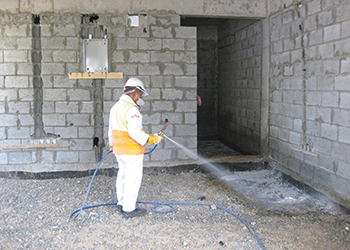Tackling the pest menace
01 May 2017
Wood, which is extensively used in buildings, is prone to extensive damage by termite infestation – which can be prevented by undertaking pest inspection particularly during summer, says MIRZA AHMAD*.
Plywood is a structural as well as ornamental building material used the world over as an alternative to solid timber. And like any wood, it’s a wonderful supply of food for termites.
Wood pests such as termites and borer beetles attack poor quality plywood panels, creating typical mud-tunnels. Mounds of fine or granular powder can be seen under such panels.
Termites cause millions of dollars’ worth of damage to homes annually around the world and ignoring them can be costly. They attack old and new buildings, slab-on-ground homes or any other type of construction. Termites are unperturbed by boundaries or fence lines.
Termites wreak destruction at any time of the year but the subterranean termites specifically found in urban areas of Saudi Arabia often infest in summer. They form colonies underneath the soil and create little mud tunnels all the way up to the foundation of houses and buildings, and start feeding on all the wood sources they find, for their survival and reproduction.
And it is in summer that home renovation and repair are usually scheduled for – when it is also important to inspect the house for termites. These tiny pests hide and thrive unnoticed, leaving landowners oblivious to the damage they have caused.
The following signs in the house or building point to a possible termite infestation: Sawdust-like droppings; dirt or mud-like tubes or trails on the structure; damaged wooden members (like window sills); and swarming winged insects within the structure, especially in spring or fall.
 |
Alshieshakly. |
The important outdoor areas that should be inspected for termites include the foundation of houses, garages and other buildings, shelter tubes coming out from the ground, around porches, connecting patios, sidewalks, areas near kitchens and bathrooms, hard-to-access areas, windows and door frames, and areas where the soil and wood meet, such as fences, stair carriages and trellises, and any exterior electrical meter or fuse box set into the wall.
The important indoors areas for termite inspection comprise doors, window facings, baseboards, hardwood flooring, plumbing and utility pipes. Discoloration or stains on walls or ceilings may mean that water is leaking and can decay wood, which can promote termite infestation. It is important to inspect areas where water enters the foundation and flooring.
The Saudi-based pest control specialist Masa Establishment, owned by Mousaied Alshieshakly, stresses that summer is the best time for home owners or businesses to implement defence measures against termite attacks, because there’s still a lot of time before the termites start swarming. The control measures include reducing the potential infestation, preventing termite entry, and applying termiticide for the remedial treatment.
In order to achieve maximum protection against termites, Masa offers Raslan Plus 35 SC (Imidacloprid 30.5 per cent) as an anti-termite solution for pre- and post-construction application. The termiticide is an SFDA (Saudi Food and Drug Authority)-approved suspension concentrate (SC).
It has a mild and characteristic odour and can be applied to the soil before or after the construction of the structure. It is equally efficient when used during repair and renovation.
When applied to the soil, Raslan Plus can provide an effective barrier, killing any termite that comes in contact during the guaranteed period. Its water-based formulation makes it convenient to use, while it has been proven to be less hazardous to the pest control applicator and the environment when used properly.
Furthermore, Masa recommends termite inspection to be performed at least once annually even if there is already a termite protection system in place and there are no signs of termite infestation.
Masa’s pest control professionals carry out a free inspection as per the client’s demands and the requirements of the situation. Termite treatment often requires specialised equipment, knowledge and expertise in the field – hence it is best handled by a professional pest control operator familiar with construction principles and practices, which has the necessary equipment and knowledge about subterranean termites.
* Mirza Waqar Ahmad is an entomologist at Jeddah-based Masa Establishment.



